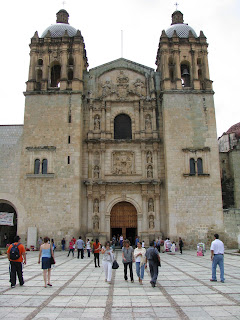 “Buenos dias Angélica. Soy Deborah. Estoy feliz de concerla.”
“Buenos dias Angélica. Soy Deborah. Estoy feliz de concerla.” My Spanish pronunciation might have been fractured, but I hope what I was trying to say — that I was extremely happy to finally meet Mexican artist and women’s rights champion Angélica Vásquez Cruz — came through loud and clear.
I finally was at her doorstep, atop a high hill just outside of Oaxaca (pronounced wa ha ka) after months of e-mail exchanges — hers in Spanish, mine translated from English to Spanish by a friend in Bloomington — and a failed attempt the day before to reach her home by taxi, when we were turned back because the roads were blocked by demonstrators in this hotbed of political activism.
I’m in Oaxaca, in far southern Mexico, to study Mesoamerican culture, both past and present, and to bring its lessons and history back to my art students at Brown County High School from this National Endowment for the Humanities summer teachers’ seminar.
Visiting with and learning from Angélica (pronounced Anhelica in Spanish) is a key part of my plan. On my second — and finally successful — attempt with cab driver Bernardo (who gave me Spanish and Zapotec lessons along the way), the roads were clear of demonstrators and I made it up the hill as far as the taxi could take me, walking the last few hundred yards of steep dirt road that seemed too extreme for any wheeled vehicle.

Angélica, a master ceramic sculptor whose art has focused on traditional cultural icons and figures from pre-European and early colonial times as well as modern pieces, would introduce me in this first of what I hope will be several hands-on lessons on how to go about making her pieces, employing centuries-old tools and techniques that she is fighting to preserve.
After a short tour of her beautiful garden, Angélica introduced me to the clays, to the 32 minerals that she crushes with a metate (a large flat stone mortar and pestle) to add to the clay for natural coloring and the simple tools we would use in this first lesson, production of a traditional angel figure.

Those tools, which Angélica calls rustica (rustic), are clay, an espina (a spine from one of her trees), water in a clay basin and a chamois cloth for smoothing edges. But the real tools are her hands, which she uses with great delicacy and expertise. Her fingers dance over the clay as she shapes and smooths the figures, occasionally moistening her fingertips to keep the clay damp. I attempted to follow along, my own fingers feeling more like bananas than ballerinas.

Finished and side-by-side, my pobre ángel (poor angel) looked so crude and lumpy next to hers. But everyone, my students at Brown County included, must start somewhere to get anywhere — and this, with its grace and long history, is worth the time to start.

 Mitla is a typical temple structure. The town is built within the compound and the Spanish Catholic Church on the ruins.
Mitla is a typical temple structure. The town is built within the compound and the Spanish Catholic Church on the ruins.


































